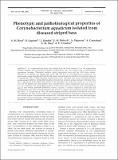Por favor, use este identificador para citar o enlazar a este item:
http://hdl.handle.net/10261/26052COMPARTIR / EXPORTAR:
 SHARE
BASE SHARE
BASE
|
|
| Visualizar otros formatos: MARC | Dublin Core | RDF | ORE | MODS | METS | DIDL | DATACITE | |

| Título: | Phenotypic and pathobiological properties of Corynebacterium aquaticum isolated from diseased striped bass |
Autor: | Baya, A. M.; Lupiani, B.; Bandín, I.; Hetrick, F. M.; Figueras Huerta, Antonio CSIC ORCID ; Carnahan, A.; May, E. M.; Toranzo, A. E. | Fecha de publicación: | nov-1992 | Editor: | Inter Research | Citación: | Diseases of Aquatic Organisms 14: 115-126 (1992) | Resumen: | A Corynebacterium strain was isolated from the brain tissues of 3 yr old striped bass Morone saxatilis with pronounced bilateral exophthalmia that were being held in experimental aquaculture facilities. Taxonomic analysis, using conventional tests and the API-Coryne system, allowed us to identify the striped bass strain (RB 968 BA) as Corynebacterium aquaticum. An agglutination assay demonstrated that the fish isolate was serologically related to the reference strain of C. aquaticum (ATCC 14665) originally isolated from water. Although both strains exhibited different surface protein patterns, immunoblot analysis revealed they shared a protein antigen of 68 kDa. Only the C. aquaticum from striped bass proved to be pathogenic for fish (LD50 values of 1.0 x 10(5) and 5.8 x 10(4) for striped bass and rainbow trout Oncorhynchus mykiss respectively) and mice (LD50 = 8.3 x 10(4)). Similarly, the extracellular products of this strain (but not of several other corynebacteria species also tested) possessed proteolytic activity, elicited a cytotoxic response in both fish and homoiothermic cell lines, showed dermonecrotic activity in rabbits, and contained exotoxins lethal for fish (LD50= 1.70 (nu)g protein g-' fish). All these biological activities, exhibited in vitro and in vivo, were concomitantly lost after heating (100ºC for 10 min). Histopathological examination showed lesions in the interna1 organs of experimentally infected fish. The brain and eyes were the most affected organs and showed acute hemorrhages. Personnel involved in culturing fish should be made aware of the pathogenic capability exhibited by C. aquaticum for mammals. | Descripción: | 12 pages, 2 figures, 3 tables. | Versión del editor: | http://www.int-res.com/abstracts/dao/v14/ | URI: | http://hdl.handle.net/10261/26052 | ISSN: | 0177-5103 |
| Aparece en las colecciones: | (IIM) Artículos |
Ficheros en este ítem:
| Fichero | Descripción | Tamaño | Formato | |
|---|---|---|---|---|
| d014p115.pdf | 2,13 MB | Adobe PDF |  Visualizar/Abrir |
CORE Recommender
Page view(s)
444
checked on 27-abr-2024
Download(s)
1.066
checked on 27-abr-2024
Google ScholarTM
Check
NOTA: Los ítems de Digital.CSIC están protegidos por copyright, con todos los derechos reservados, a menos que se indique lo contrario.
